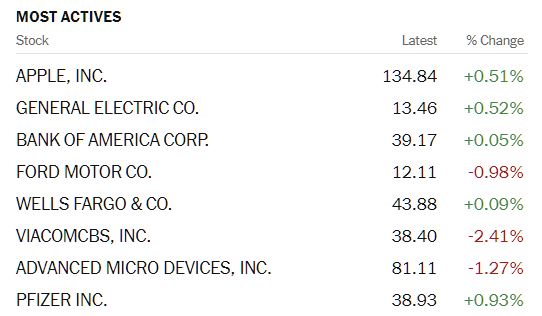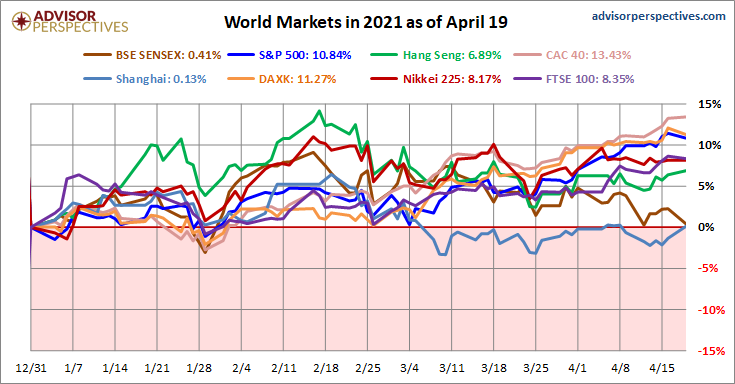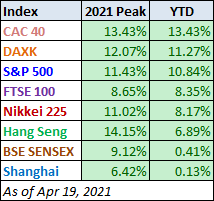Tuesday Talk: Of Rice And Rain
Rain will be welcome to grain crops from the Great Plains to the Canadian prairie to Northern Brazil. On the other hand the "raindrops" felt in the stock market yesterday may be less welcome to many investors. On Monday the S&P 500 closed at 4,163, down 22 points, the Dow closed at 34,078, down 123 points and the Nasdaq closed at 13,915, down 138 points. This morning futures for all 3 indices are trading slightly down. Too early to tell if it is just a light drizzle or an umbrella is needed.

A look at the most actives yesterday shows action across all sectors; technology, financial, industrials, entertainment and pharma.

Source: The New York Times
TalkMarkets contributor Jack Scoville in his Grains Report - Monday, April 19 notes that rain is a factor for grain crops across both the Northern and Southern Hemispheres.
"Wheat - Wheat markets were higher last week as Wheat remains a weather market. The weather remains too dry in the northern Great Plains and in the Canadian Prairies and farmers can’t plant. It has been very cold and some Winterkill was possible in the central and southern Great Plains. Any damage is expected to be light. Demand remains disappointing (WEAT)...
Rice - Rice was a little lower on Friday and for the week on what appeared to be speculative selling tied to ideas of weaker demand. Demand has been solid for exports but less for the mills...Texas is about out of Rice, but there is Rice available in the other states, especially Arkansas. Asian and Mercosur markets were steady to lower last week. New crop Rice is getting planted in Texas and planting is more than three-quarters done in Louisiana. Mississippi and Arkansas are starting planting.
Corn and Oats - Corn (CORN) closed higher on what appeared to be speculative buying based on ideas of strong demand and long-term weather outlooks for warm and dry weather west of the Mississippi River. There are also concerns about the production potential for the Safrinha crop in Brazil. Oats were higher. Chinese demand had been strong until recently and it looks like they need the Corn. Prices inside China for Corn remain extremely high. In Brazil,Winter Corn crop progress is well behind normal and it has been dry in major growing areas. Some showers are possible in southern areas this week...Demand for US Corn has been coming at a stronger pace than estimated by USDA and it looks like US ending stocks can be significantly less than current projections by the end of the year.
Soybeans - Soybeans (SOYB) were higher and Soybean Meal was about unchanged last week. Soybeans have been rallying with Corn and Soybean Oil. Also, there is still crush demand and export demand even though the demand is less now than before. The US does not have a lot of Soybeans in the country anymore as most producers have already sold. Buyers are scrambling for what is left. The Brazil harvest had been delayed due to late planting dates early due to dry weather...Harvest activities have increased but the harvest remains very slow overall. China has been buying for next year here but now is buying mostly in South America. US internal demand has been strong. Soybean Meal is under pressure on ideas of big production caused by the big rally in Soybean Oil. Production of DDG can increase in the near future as ethanol demand improves and more people start driving again."

Despite the setbacks in Europe due to continued lockdowns and slow vaccination rollouts Jill Mislinski writing in World Markets Update: April 19, 2021 surprises us with charts that show both the CAC and the DAX leading the pack on a year to date basis.
"All eight indexes on our world watch list posted gains through April 19, 2021. The top performer is France's CAC 40 with a gain of 13.43%, Germany's DAXK is in second is with a gain of 11.27% and our own S&P 500 is in third with a gain of 11.43%. Coming in last is China's Shanghai with a gain of 0.13%.
Here are all eight world indexes in 2021 and the associated table sorted by YTD."


Mislinski also includes historical charts of world indices from 2009, 2007 and 2000 to date.
In a TalkMarkets Editor's Choice column entitled Why The Riskiest Stocks Have Been Vastly Outperforming Safe Ones contributor Yuval Taylor draws some interesting charts and conclusions which will leave readers with plenty of food for thought. Taylor starts out with the following daunting proposition:
"Let’s say you believed that the higher the risk, the higher the reward. Let’s say you loved taking risks. Let’s say you participated in all the Red Bull–sponsored extreme sporting events you could, and you watched those you couldn’t participate in. And you drank their sodas like water, regardless of any health risks. What kinds of stocks would you buy?"
So that's the kind of market we're in? Taylor continues:
"A Red Bull investor would look for the following in a stock:
- Value. Extremely underpriced or extremely overpriced stocks. Those are definitely the riskiest.
- Growth. Stocks whose growth is high but far from certain. Again, definitely the riskiest.
- Stability. The most unstable stocks possible.
- Quality. Low-quality stocks. No question there.
- Sentiment. Stocks with huge changes in sentiment; stocks which investors can’t make up their minds about; stocks that are either flying under the radar or are heavily shorted.
- Momentum. Total mean reversion! Stocks with negative momentum. Beaten-down stocks that are barely hanging on.
- Size. Tiny stocks, low-priced stocks."
So how does this all stack up? You might be surprised. Contrarian investing, perhaps, but I've got to give a cheer to Taylor for his wet and novel analysis.
"Check out the following charts:
The left-hand charts are for these factors between January 1999 and April Fools’, 2020, a few days after the market hit bottom. The right-hand charts are for the most recent four quarters, 4/1/2020 to 4/1/2021. Let’s focus on the right-hand charts for a moment.
- Value. As you can see, the most expensive stocks have gone up the most, but besides that, there’s been a steady favoring of cheap stocks as well. The fairly-priced stocks have done the worst.
- Growth. These factors have been relatively unaffected. Growth stocks still rule supreme.
- Stability. The most unstable stocks have outperformed like mad.
- Quality. Low quality is highly favored.
- Momentum. Stocks with terrible (or downward) momentum have done by far the best; stocks with high momentum have done OK, but only at the very top end of the chart.
- Sentiment. Stocks that are undergoing major changes in sentiment, whether higher or lower, are doing the best.
- Size. The tiniest stocks are crushing the others."
Talk about the U.S. housing market continues unabated. Low mortgage rates, short supply, Millennial first home madness and so forth. Yes, the market remains on and Sreoshi Bera in 5 Stocks To Tap Into The Booming US Housing Market has some ideas for investors who want to participate in the party.

"5 Stock Picks
Given the current scenario, the housing market is doing well despite the constant supply-side headwinds. Hence, we have shortlisted five housing and related companies’ stocks that are poised to grow.
Louisiana-Pacific Corporation (LPX) manufactures and markets building products, primarily for use in new home construction, repair and remodeling, and outdoor structure markets. The company’s expected earnings growth rate for the current year is 68.7%...The Zacks Consensus Estimate for this company’s current-year earnings has been revised 58.7% upward over the past 60 days. Louisiana-Pacific flaunts a Zacks Rank #1 (Strong Buy).
Forterra, Inc. ( FRTA) manufactures and sells pipe and precast products. The company’s expected earnings growth rate for the current year is 38.3%...The Zacks Consensus Estimate for this Zacks Rank #1 company’s current-year earnings has been revised 27.5% upward over the past 60 days.
KB Home (KBH) builds and sells various homes, including attached and detached single-family residential homes, townhomes, and condominiums. The company’s expected earnings growth rate for the current year is 81.5%...The Zacks Consensus Estimate for this company’s current-year earnings has been revised 11.2% upward over the past 60 days. KB Home carries a Zacks Rank #2 (Buy).
Lennar Corporation ( LEN) engages in homebuilding operations, which include the construction and sale of single-family attached and detached homes...The Zacks Consensus Estimate for this Zacks Rank #2 company’s current-year earnings has been revised 23.9% upward over the past 60 days.
M.D.C. Holdings, Inc. (MDC) engages in homebuilding and financial service businesses...The Zacks Consensus Estimate for the company’s current-year earnings has been revised 15.6% upward over the past 90 days. M.D.C. Holdings carries a Zacks Rank #2."
Bera prefaces these stock picks with some solid reporting about the US housing market overall. Good reading. As always, caveat emptor.
While it is true that market indexes closed at record highs last week and the U.S. economy seems to be getting well back on its' feet with strong support from Biden's stimulus package and the anticipated infrastructure bill to come, not all pundits are convinced. Closing out this week's column are these remarks from contributor Jesse of Jesse's Cafe Americain. Writing in Stocks And Precious Metals Charts - Cryptic Valuations And The Bubble From Hell - At The Quiet Limit Of The World Jesse has this to say:
Have a good week.





The very wise advice given to gamblers has been " Do not gamble more than you can afford to lose", and this rather obviously applies to stocks as well. And the other, equally as wise advice, ha been to not gamble with borrowed money. So in the stock markets they call it "leverage" so a to make it sound less dangerous.
The really interesting part of the whole thing is that some folks do quite well even as they go in the opposite direction, gambling far more than they can afford to lose, and doing it all with borrowed (leveraged) funds. That is a puzzle that I have no hint of solving. And a game that I have chosen to not play. I may occasionally wager, but I never ever gamble.
A wise wager is better than a brash bet, though Yuval Taylor presented a contrarian analysis 🧐
I thought @[Yuval Taylor](user:19067) made some excellent points.